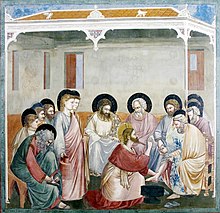Washing feet

The foot washing (lat. Mandatum "Order, Law") is a ritual act that in the Orient the hospitality symbolizes (as in the Old Testament : 1 Mos 18,4 EU ). The washing of the feet is described in the Gospel of John of the New Testament as an act of Jesus to his disciples. The rite has its liturgical name from the words of Jesus' Mandatum novum do vobis ( Jn 13.34 VUL , “I give you a new commandment”) .
The washing of feet at the last supper
On the eve of his death on the cross , Jesus Christ washed his disciples ' feet during the Last Supper and dried them with the cloth that girdled him. Through this example, he wanted to show that the disciples must also be ready to serve one another. Only the Evangelist John describes the event ( John 13 : 1–11 EU ), which is continued and developed through the farewell speeches of Jesus and his high priestly prayer ( John 13–17 EU ). The Gospel of John does not mention the institution of the Eucharist at the Lord's Supper ; the subject of the Eucharistic figure of the body of Christ can be found here in a conversation between Jesus and the Jews, Jn 6,27-59 EU (especially verses 51 to 58).
Peter did not want to let Jesus wash his feet at first, but let it happen after he said to him: "If I do not wash you, you have no part in me" ( Jn 13.8 EU )
Rite of the washing of feet in worship

In some churches the rite of washing the feet is practiced regularly.
Roman Catholic Church
In the Catholic Church , washing the feet is part of the liturgy of Maundy Thursday . Before the reform of the Holy Week liturgy in 1955, the rite was performed separately from the celebration of Holy Mass “at the appropriate hour” and only in episcopal and monastery churches, often in the Karmette in the morning or during the morning. In addition, the antiphon Ubi caritas was sung with the verses of the hymn Congregavit nos in unum Christi amor .
Since 1956, the washing of the feet has been part of the celebration of the Last Supper, compulsory in cathedral and abbey churches, and optional in all other churches. The celebrant of the Holy Mass washes the feet of twelve (locally also fewer) previously designated believers; the rite belongs to the sacramentals . In the diocese of Milan , in the time of St. Ambrose, the washing of the feet was practiced as part of the sacrament of baptism .
Following a request from Pope Francis , the Congregation for Divine Worship and the Order of the Sacraments published a decree in January 2016, according to which in future the washing of feet can be performed on all believers. Those who are selected should “make themselves available in all simplicity.” Combined with a historical review of the liturgical-historical development of the mandate, the implementation of the Pope's request for reform is explained in an accompanying letter from the Congregation.
Eastern Orthodox Churches
In the Orthodox Churches in the Patriarchate of Jerusalem it is customary for the Patriarch to wash the feet of twelve priests on the occasion of Great Thursday . A similar rite takes place every year on the morning of the Great Thursday in the Johannes monastery on Patmos.
Protestantism
In Protestantism , the washing of the feet is practiced among other things by the Seventh-day Adventist Churches , the Church of God Germany KdöR and the Free Church Covenant of the Church of God and partly also with the Mennonites . With the Mennonites the washing of feet takes place in connection with the Lord's Supper as an introductory part. It is also dealt with in the Mennonite Dordrecht Confession of 1632.
literature
- Hildegard Giess: The depiction of the washing of the feet of Christ in the artworks of the 4th – 12th centuries Century . Herder, Roma 1962.
- Wolfram Lohse: The washing of the feet (Joh 13, 1–20). A story of their interpretation . Diss., Erlangen 1967 (2 vol.).
- Georg Richter: The washing of the feet in the Gospel of John. History of their interpretation . Biblical research 1. Pustet, Regensburg 1967.
- John Christopher Thomas: Footwashing in John 13 and the Johannine Community . JSNTSup 61. Academic Press, Sheffield 1991, ISBN 1-85075-308-3 .
- Christoph Nobody : The story of the washing of feet in the Gospel of John. Investigations into their origin and tradition in early Christianity . Studia Anselmiana 114. Pontificio Ateneo S. Anselmo, Rome 1993.
See also
- The washing of the feet of Christ (Bode Museum) , Byzantine relief
- The regent washing his feet (Bavaria)
- Foot kiss
Web links
- Foot washing ceremony in the Vienna Hofburg
- Pope Benedict XVI washes twelve laypeople's feet on Maundy Thursday
- Christian Wetz: foot washing (NT). In: Michaela Bauks, Klaus Koenen, Stefan Alkier (Eds.): The Scientific Bibellexicon on the Internet (WiBiLex), Stuttgart 2006 ff., Accessed on January 27, 2013.
Individual evidence
- ↑ http://www.vatican.va/roman_curia/congregations/ccdds/documents/rc_con_ccdds_doc_20160106_decreto-lavanda-piedi_ge.html
- ↑ http://www.vatican.va/roman_curia/congregations/ccdds/documents/rc_con_ccdds_doc_20160106_commento-decreto-lavanda-piedi_ge.html
- ↑ Guide. (PDF; 295 kB) (No longer available online.) Association of German Mennonite Congregations in the AMG, archived from the original on August 4, 2007 ; Retrieved April 2, 2010 . Info: The archive link was inserted automatically and has not yet been checked. Please check the original and archive link according to the instructions and then remove this notice.
